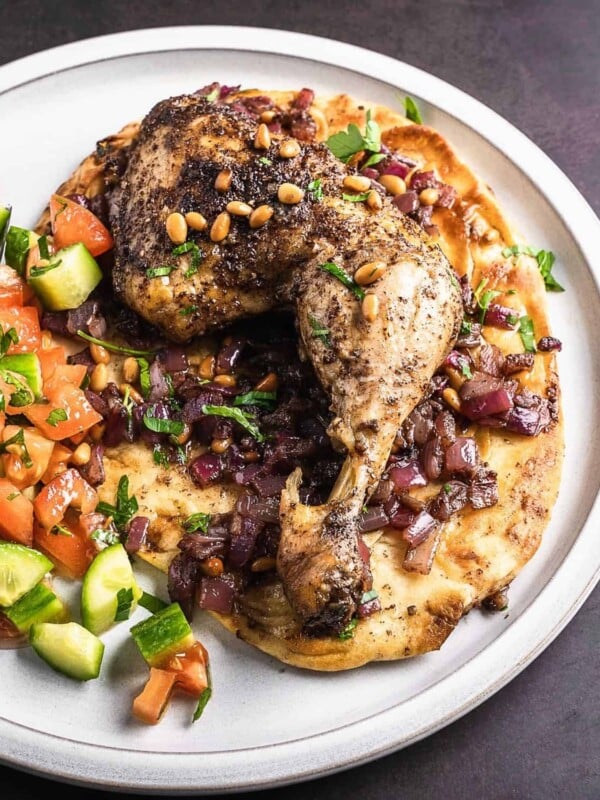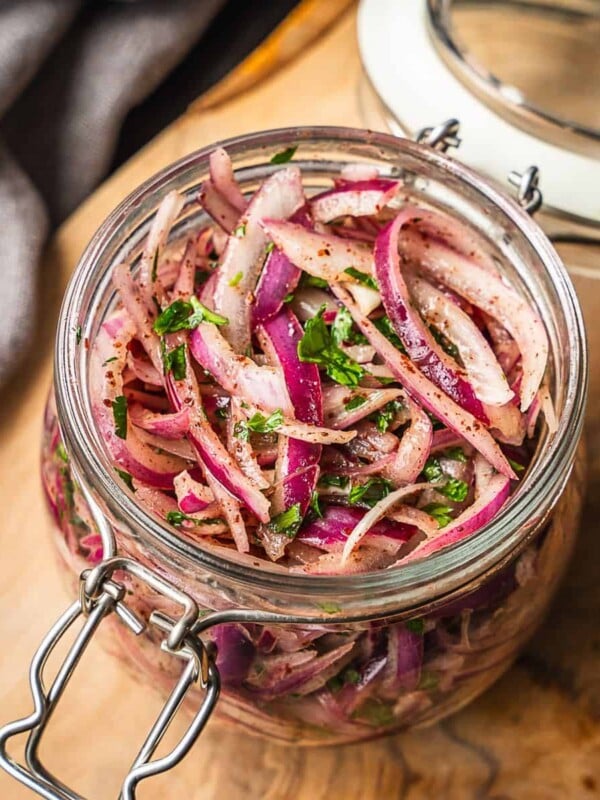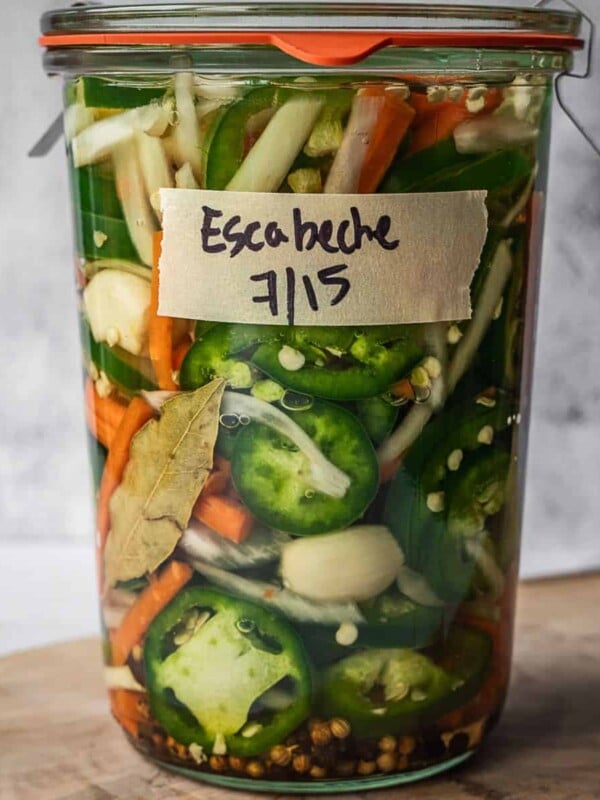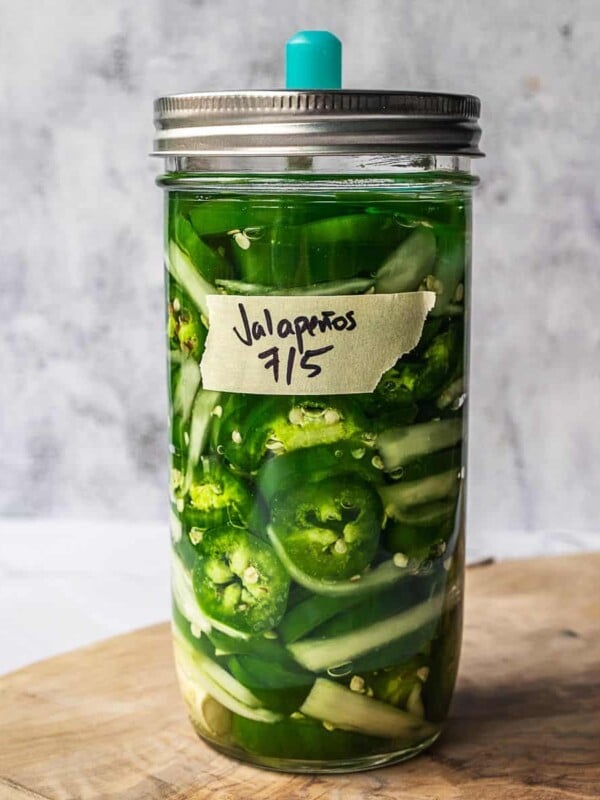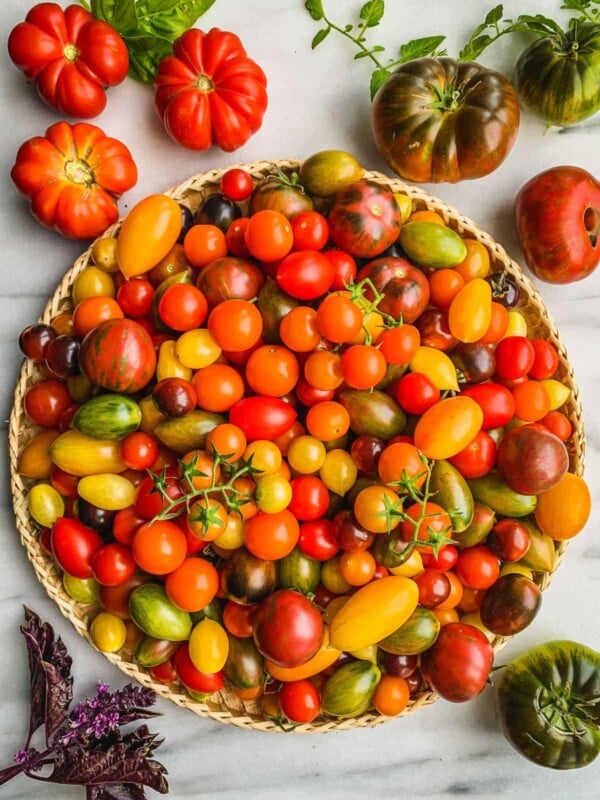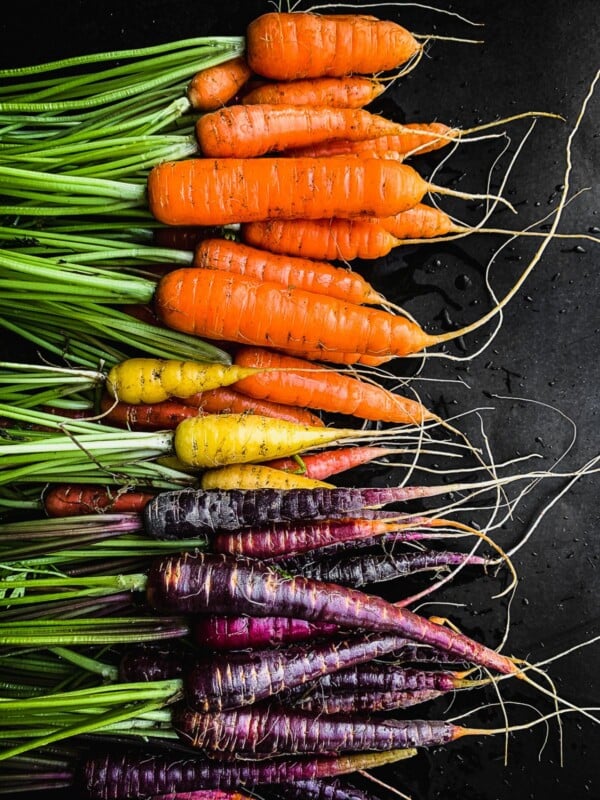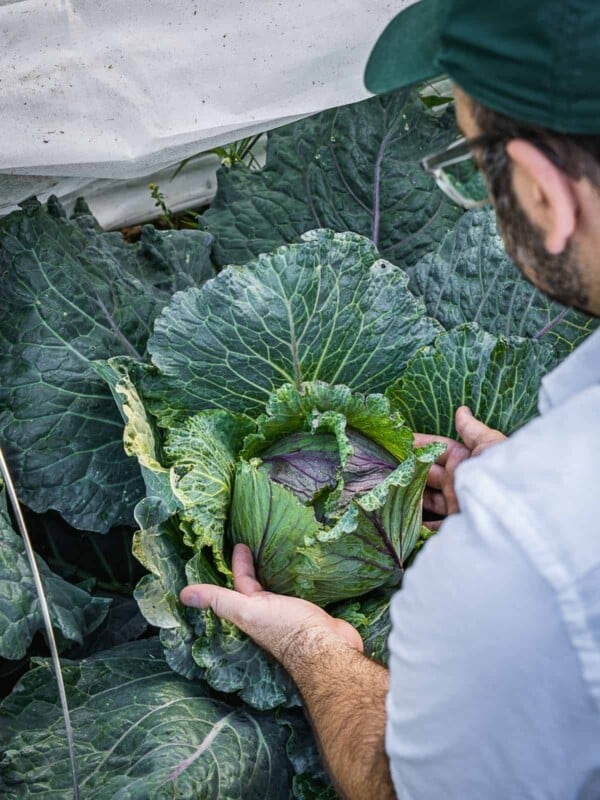Onions (Allium cepa), shallots (Allium ascalonicum), and leeks (Allium ampeloprasum) all belong to the Amaryllidaceae family, which also includes green onions, garlic, ramps, and chives.
This post will cover a range of topics including varieties, how to grow onions, harvest, store, preserve and enjoy.

Table of Contents
Onion Overview
While onions are so ubiquitous in cooking, remember the other members of this family. With their delicate onion flavor and a hint of garlic, shallots can enhance dishes without overpowering other ingredients. With their mild, sweet onion flavor and tender texture, Leeks are often used in soups, stews, and casseroles, adding depth and complexity.
The origins of alliums date back to ancient times, with evidence suggesting their cultivation in regions from Asia to the Mediterranean. Initially, these alliums were likely wild plants with small bulbs, primarily valued for their flavor and medicinal properties.

Over centuries of cultivation and selection, these plants underwent a significant transformation, resulting in the diverse array of varieties we know today.
Rich in essential nutrients such as vitamin C, vitamin B6, and folate, onions, shallots, and leeks are believed to have health benefits. Onions, in particular, are known for their sulfur compounds, which contribute to their distinct flavor and potential health-promoting properties.
Culinary Uses
Alliums are essential in cuisines worldwide, adding depth, flavor, and nutritional value to countless dishes. Some of the leading culinary uses for onions include:
- Base flavor/aromatic: Onions create a flavor base in cooking, providing a foundational element to dishes such as soups, stews, sauces, and curries. You can see examples of this in French cooking with mirepoix (sauteed onions, carrots, and celery) and in Cajun cooking with the holy trinity (sauteed onion, celery, and bell peppers).
- Raw: Raw onions add a crisp texture and savory flavor to salads and sandwiches. Finely diced raw onions, shallots, or green onions (scallions) are also often used as a garnish to add a pop of color, freshness, and flavor to finished dishes, such as soups, chili, nachos, or baked potatoes. If you find raw onions too strong, you can soak your prepared onions in cold water, which will leach out some of the sulfur compounds, resulting in a milder flavor.
- Stir-fries and sautéed dishes: Onions are often included in stir-fries and sautéed dishes to provide flavor and texture. When cooked, their ability to soften and caramelize adds richness and complexity to these dishes.
- Grilled or Roasted: Grilled or roasted onions develop a sweet, caramelized flavor and tender texture. They are often added to sandwiches or burgers or incorporated into various recipes for added depth of flavor.
- Pickled: Pickled onions have a tangy, acidic flavor and are commonly used as a condiment or garnish in sandwiches, salads, tacos, and other dishes. Try my Mexican Pickled Onions.

Onion Varieties
- Yellow Onions are the most widely used onions. They have a strong, pungent flavor. They are versatile and used in various culinary applications, from soups and stews to stir-fries and casseroles.
- White Onions have a milder flavor (when compared to yellow onions) and a slightly sweeter taste. They are commonly used in Mexican cuisine, raw in salsas, salads, and sandwiches.
- Red Onions: Red onions have a mild to moderate flavor, a slightly sweet taste, and a hint of spiciness. They are often used raw in salads, sandwiches, or pickles, where their vibrant color adds visual appeal.
- Sweet Onions include varieties like Vidalia, Walla Walla, and Maui and are known for their high sugar content and mild flavor. They are excellent in applications where sugar is concentrated, such as when grilled or caramelized.
- Shallots have a mild, sweet flavor with a hint of garlic. They are smaller than onions and have a purplish-brown skin. Shallots are commonly used in French cuisine and are chosen for their delicate flavor, often used in vinaigrettes, sauces, and dressings.
- Spring Onions/Scallions are young onions harvested before the bulb fully develops. They have a mild flavor with a slightly sharp bite and are commonly used raw as a garnish in salads, soups, and Asian dishes.
- Bunching onions are similar to green onions but don’t bulb, often growing closer together in clusters or bunches.
- Leeks are characterized by their long, cylindrical stalks with white, pale green, and dark green layers. They have a more delicate, sweet flavor than onions and pair well with butter.

Though chives are a part of the onion family, I like to treat them more like an herb as they have a similar growing pattern to perennial herbs like thyme and oregano.
A Note on Day Length
Unlike many other crops, when you grow onions, you must consider the day length (the number of hours of daylight) and buy the appropriate variety. The day length influences the bulb formation and maturation process. Onions’ response to day length is genetically determined.
Planting the wrong onion for your day length can result in poor bulb formation, delayed maturity, or premature bolting.
Long-day onions require longer daylight; they only start forming bulbs when the day length reaches a certain threshold, typically around 14 to 16 hours. They are well-suited for growing in northern regions with longer summer days. Examples of long-day onion varieties include ‘Walla Walla’ and ‘Yellow Globe.’
Short-day onions start forming bulbs when the day length is shorter, usually around 10 to 12 hours. They are best suited for regions with milder winters and shorter daylight hours, such as southern latitudes. Short-day onions mature earlier, in the spring or early summer. Examples of short-day onion varieties include ‘Texas Grano’ and ‘Granex.’
Indeterminate, or day-neutral, onions have been developed through breeding programs to give growers flexibility in planting and harvesting schedules. They can form bulbs under a wide range of day lengths, making them adaptable to various growing conditions. Examples of intermediate-day onion varieties include ‘Red Candy Apple’ and ‘Candy.’

Suitability for Small Gardens and Containers
While you can grow onions in a small space or a container, they require a significant amount of garden space per bulb. Consider sticking with green onions or scallions if you have a smaller space. You can treat them more like an herb and trim the top off or harvest the whole onion if needed.
When to Plant
When you plant your onions will be determined by how you choose to grow them.
From seed: Start seeds inside about 8-10 weeks before your last frost date.

From sets: Plant sets outside when the soil can be worked. You can plant your sets inside under light to give them a head-start (more on this later).
How to Grow Onions, Shallots, and Leeks
Starting from Seed Indoors
To sow seeds: Sow onion seeds evenly across the growing medium’s surface (use a commercial seed starting mix). Press the seeds lightly; you can cover them lightly with more medium. They can be sown very tightly, as it does not damage the roots to pull them apart later when planting. Start them in cell packs, soil blocks, or even a single seed tray.
Water: Gently water the growing medium to ensure it’s evenly moist but not soggy; mist the surface with a spray bottle to avoid disturbing the seeds. Water as needed to keep it consistently moist but not soggy. Avoid letting the medium dry out completely.
Provide light and warmth: Place the seed trays in a warm, well-lit area with plenty of sunlight or under grow lights. Onions require temperatures between 65°F to 75°F (18°C to 24°C) for optimal germination.
Fertilize: Feed them with a balanced fertilizer diluted to half or quarter strength about every two weeks.
Trim: You can trim the tops of your onions down 4-6 inches tall as they grow to keep them manageable inside. Trimming is not necessary, but it can make it easier to plant them.

Harden off: Ideally, about a week before transplanting seedlings outdoors, when the weather is overcast, start bringing your seedlings outside for more extended periods each day. Start with an hour or two and increase the time outside each day.
Starting from Sets Outdoors
Onion sets are small, dormant onion bulbs used for planting. They are essentially young onion bulbs grown from seed the previous year and then harvested and stored for planting in the following growing season. Using onion sets can provide a head start on the growing season, allowing you to harvest onions earlier than starting from seed.
Start with good sets: Choose high-quality onion sets from a reputable source. They should be firm, free from mold or disease, and approximately the size of a marble but no larger than 3/4 of an inch in diameter.
Planting: Dig a trench in the soil approximately 1 to 2 inches deep. Place the onion sets in with the pointed end facing upwards.
Cover with soil: Gently cover the onion sets with soil, but not too deeply; the tops of the sets should be just below the soil surface.
Water: After planting, water the soil thoroughly to settle it around the onion sets and provide moisture for germination. Ensure the soil remains consistently moist but not waterlogged throughout the growing season.
Get a head start: If you live in an area with a shorter growing season, it can be beneficial to start your sets inside. However, if you do this, the onions may have a higher risk of bolting.
Plant the onion sets in the potting mix with the pointed end facing upward at a depth of about 1 inch spaced evenly in the containers. Just like starting from seed (see above), you will need to provide light, consistently water and feed them, and harden them off before planting outside.
Planting Nursery Starts or Homegrown Seedlings
You can also buy onion starts or transplants from a local nursery or an online retailer. They are the same as young onions started from seed, although they are generally a little further along.

At this point, onion roots are very hardy and can take some damage, so do not worry if you need to pull apart your seedlings.
Plant Spacing
Row spacing: Space the sets or transplants about 4 to 6 inches apart in rows 12 to 18 inches apart. If you’re planting multiple rows, space them at least 12 inches apart. If you have enough space between plants, your onions will grow larger.
Square foot spacing: You can plant as many as 16 onions per square foot, but they will be small. Plant 4-9 onions per square foot if you want larger bulbs. One way to optimize spacing is to plant more in a square foot but pull some as green onions to make way for the remaining to form larger bulbs.
Special Planting Requirements for Leeks
When we eat leeks, the most popular part is the long white portion of the stem. This part remains white because it is under the soil while growing. Because of this, it is best to start leek seedlings in a trench about six inches deep, filling in the trench as the leeks grow (this is a blanching method).

Blanching Leeks
Blanching leeks helps to produce longer, tender, white stalks by keeping that portion of the plant from sunlight. There are a couple of different ways to accomplish this.
Trench: Start with a trench six inches deep and plant the leeks at the bottom. As they grow, backfill the trench so more of the plant is under the soil.
Hill: When the leeks are a good size, gently hill soil (or straw, or much) up around the plant. Repeat this process a few times throughout the season.
How to Maintain
Fertilize: Alliums are heavy feeders and can use a decent amount of nutrients. Before planting, mix a balanced granular organic fertilizer into the soil with other amendments like worm castings and manure. Side dress with additional granular fertilizer or compost several times throughout the season. Be careful not to provide too much nitrogen later in the season, as this will lead to more leaf growth.
Water: Alliums do best with consistent watering. It is best to monitor the moisture level in the soil before you water to ensure they are not getting overwatered.
Weed: Alliums do best without competition, so make sure to keep your onions well-weeded.

Common Pests and Diseases
Onion maggots Are small, cream-colored maggots that turn into brown flies that will eat your alliums. The ideal way to prevent them is to use row covers.
Onion thrips Are tiny, slender insects that feed on plant sap by puncturing the leaves. They damage foliage, reduce plant vigor, and can also carry disease. To prevent these, use row covers, practice crop rotation, weed consistently, and plant thrips-resistant onion varieties. You can also plant native wildflowers to attract beneficial insects such as lacewings, which will help control the population.
White rot: Can cause leaf yellowing, rotting bulbs, stunted growth, and overall plant decline. Planting disease-resistant varieties, maintaining proper spacing and ventilation, and practicing good sanitation can help prevent and manage diseases. If you find this on your onions, remove and destroy infected plants (do not put them in your compost) and plant your onions in a different area the following year.
When to Harvest
You can harvest onions and use them at any point during their growth. However, you will know that they are ready for harvest to store when their tops fall over, and the neck (the section between the leaves and the bulb) is soft. Avoid harvesting onions when the soil is wet, as excess moisture can lead to rotting during curing.

Best Way to Store Homegrown Onions
The two most important things about storing homegrown onions are:
Curing: This is an essential step in preparing them for long-term storage.
It helps toughen the outer skins, reduce moisture content, and improve the flavor and shelf life. Lay the onions in a single layer in a warm, dry, well-ventilated location with good air circulation out of direct sunlight. Leave the onions for 1 to 2 weeks, turning them occasionally to ensure even drying.
They are ready when the outer skins of the onions are dry, papery, and tightly attached to the bulbs. The necks should be completely sealed, and the bulbs should feel firm.

Grow storage varieties: Some onion varieties will keep longer than others. Most yellow onions will last many months, while most sweet onions will start to sprout or rot much faster. Many onion varieties are bred to store well, often labeled as storage onions.
Once the onions are fully cured, gently brush or rub off any loose or flaky outer skins by hand. Do not remove the entire outer skin, as it helps protect the bulbs during storage. Keep the onions in a cool, dry, and well-ventilated location. A basement, pantry, or root cellar with temperatures around 32-40°F (0-4°C) and 60-70% relative humidity is ideal for long-term onion storage.
Onion Recipes To Try
Main Dishes
Levantine Recipes
Preservation
Fermentation
Check out some of my other grow guides: Growing Squash, Growing Carrots and Growing Cabbage.
If you have any questions, please take a moment to leave a comment below. It’s such a help to others who want to try the recipe.
For more Urban Farm and Kitchen, follow along on Instagram, Facebook, and Pinterest, visit the Urban Farm Shop, or subscribe for new posts via email.
